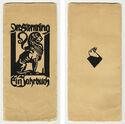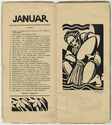
19th, 20th & 21st Century Fine Prints
707-546-7352 · fax 707-546-7924 · web: www.annexgalleries.com · email: artannex@aol.com
Aloys Rohr Biography
Aloys Rohr
German
1887–1953
Biography
Expressionist sculptor and printmaker Aloys Röhr was born December 18, 1887 in Münster, Germany, the first of six children of photographer Carl Albert Röhr and his wife Gertrud Johanna Röhr. While his formal school career is unknown, from 1904 to 1907 he trained as a sculptor with Anton Rüller in Münster. During this time made replicas of Gothic sculpture and clay works for the Munster art dealer Max Heimann. As a result of this activity, he was involved in a lawsuit against Heimann for art forgery in 1911, which he survived unscathed.
The completion of his voluntary one-year military service enabled Röhr to study at the Academy of Fine Arts in Munich from 1909 to 1910, under Professor Erwin Kurz. Between 1910 and 1914, which he called his 'years of apprenticeship and travel', led him back to Münster via Berlin, Cologne and Düsseldorf. During World War I, Röhr served on the fronts in the Vosges and Macedonia, after which he was deployed as a member of the provisional Reichswehr in 1918/'19 in the eastern border guard in Silesia. During his service he captured his observations in ink and pencil drawings that he sent as postcards to friends and family.
After his return to Münster in 1919 he and artists Albert Mazzotti, Friedrich Liel, Bernhard Bröker, Ernst Hermanns, and Bernhard Peppinghege co-founded "Schanze", a free artists' community in Münster, and occasionally worked as a wood carver in Max Fischer’s cabinetmaking workshop. In 1929 the Christian "Munsterische St. Luke community" was founded, of which he also became a member. From 1921 he was employed in the plaster molding workshop of Peter Mazzotti in Münster, and he remained loyal to this company until 1944, even under his successor Albert Mazzotti, carrying out numerous commissioned works based on Mazzotti's and his own designs. He would eventually move into a room on Ostmarkstrasse, which he also used as a studio until it was destroyed in a bomb attack in World War II.
From 1924 to 1926 he was commissioned by merchant and patron Ludwig Roselius sculpt figures of the Seven Lazy Brothers, figures of a local Bremen legend, and some interior reliefs in the House of the Seven Lazy Brothers (which still stands today). Roselius also commissioned interior decor for St. Petrus in the Böttcherstraße, which led to further commissions beginning in 1928 for sculptures and reliefs in numerous churches and chapels; to prepare for some of these works, he undertook study trips to Greece, Italy and North Africa in the 1930s. However, as the rise of Nazism took over Germany and Modernist artists were labeled 'degenerate', Röhr - who chose not to join Hitler's national socialist German worker's party - held his last major solo exhibition at Münster's Galerie Clasing in 1935. Though he continued to create, he all but disappeared from the German art scene for many years.
After his studio was destroyed in 1944, Röhr moved in with relatives on their farm in Albersloh and took up work in the Bernard Rose joinery. On January 1, 1945, the 57-year-old was drafted into the Reichswehr as a technical draftsman and stationed in Xanten. Before the end of the war he was able to return to Münster and take part in an exhibition in the Clasing Gallery with other artists from Münster. After the war, Röhr lived a very secluded life and carried out various commissions for the reconstruction of Münster, including the gable figures on the town hall and various columns and reliefs on the commercial buildings on Prinzipalmarkt and Salzstraße.
Aloys Röhr died on March 1, 1953 in Albersloh, Germany. In 2009 the Münster Stadtmuseum held an exhibition of his work after several years of research on the artists whose works had, until then, been mostly lost to the public. In 2012 his was was also included in the museum's "Adaptation - Survival - Resistance", an exhibition of works by German Modernists created under the Nazi regime, and in 2017 they held a small exhibition of his field postcards from World War I. Röhr's work is held in the Stadtmuseum and the Kunsthandel Henneken.


